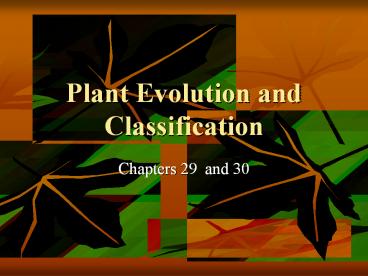Plant Evolution and Classification - PowerPoint PPT Presentation
Title:
Plant Evolution and Classification
Description:
Plant Evolution and Classification Chapters 29 and 30 Key Concepts Plants moving from water to land Classification of plants Alternation of generations Plant ... – PowerPoint PPT presentation
Number of Views:163
Avg rating:3.0/5.0
Title: Plant Evolution and Classification
1
Plant Evolution and Classification
- Chapters 29 and 30
2
Key Concepts
- Plants moving from water to land
- Classification of plants
- Alternation of generations
3
Plant Characteristics
4
(No Transcript)
5
Challenges to life on land
6
Challenges to life on land
7
Challenges to life on land
8
Challenges to life on land
9
Challenges to life on land
10
(No Transcript)
11
Focus on Mosses
- TheGametophyte Generation
- The leafy shoot of mosses is haploid and thus
part of the gametophyte generation
12
Mosses continued
- three kinds of shoots
- female, which develop archegonia at their tip
- A single egg forms in each archegonium.
- male, which develop antheridia at their tip
- Multiple swimming sperm form in each antheridium.
- sterile, which do not form sex organs.
13
Mosses continued
- In early spring, raindrops splash sperm from male
to female plants. These swim down the canal in
the archegonium to the chamber containing the
egg. The resulting zygote begins the sporophyte
generation.
14
Mosses continued
- The Sporophyte Generation
- Mitosis of the zygote produces an embryo that
grows into the mature sporophyte generation. It
consists of - a foot, which absorbs water, minerals, and
probably some food from the parent gametophyte. - a stalk, at the tip of which is formed a
- sporangium.
15
Mosses continued
- The sporangium is
- filled with spore mother cells
- sealed by an operculum, and
- covered with a calyptra. The calyptra develops
from the wall of the old archegonium and so is
actually a part of the gametophyte generation. It
is responsible for the common name ("haircap
moss") of this species.
16
Mosses continued
- During the summer, each spore mother cell
undergoes meiosis, producing four haploid spores
- the start of the new gametophyte generation. - Late in the summer, the calyptra and operculum
become detached from the sporangium. Low humidity
causes the ring of teeth within the opening of
the sporangium to pop outward ejecting the spores.
17
Mosses summary
- These tiny spores are dispersed so effectively by
the wind that many mosses are worldwide in their
distribution. - If a spore reaches a suitable habitat, it
germinates to form a filament of cells called a
protonema. Soon buds appear and develop into the
mature leafy shoots. - The gametophyte generation is responsible for
sexual reproduction - The sporophyte generation is responsible for
dispersal.
18
- http//www.sirinet.net/jgjohnso/lifecyclesplants.
html
19
Classification
- Non-vascular vs. vascular
- What does vascular mean?
- Xylem transports water from roots to rest of
plant - Phloem transports sugars and nutrients
throughout plant
20
Classification
- Seedless vs Seeds
- What is a seed?
- Plant embryo packaged with a store of food within
a resistant coat - http//www.sirinet.net/jgjohnso/lifecyclesplants.
html
21
PLANT STATIONS
- I. Bryophytes
- II. Ferns
- III. Pine Life Cycle
- IV. Angiosperms

